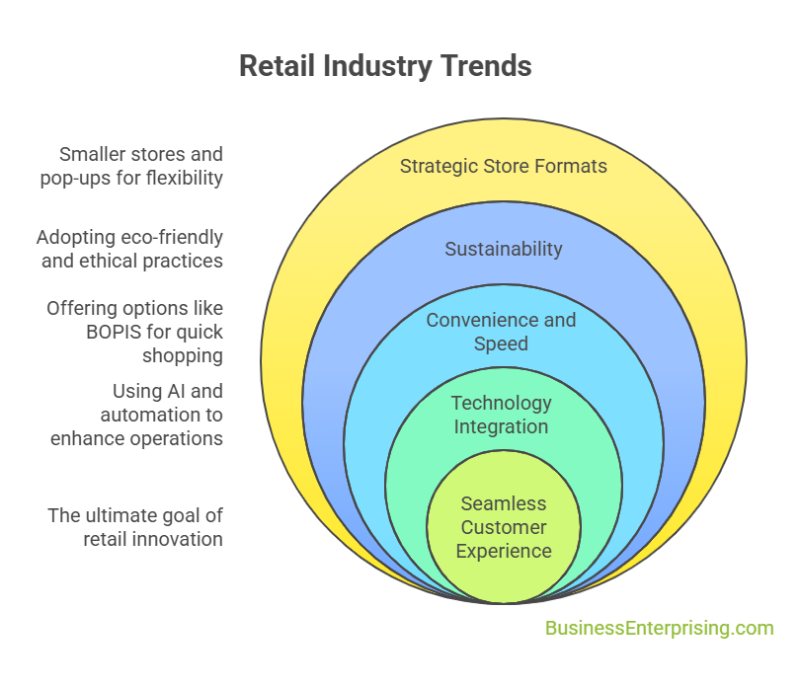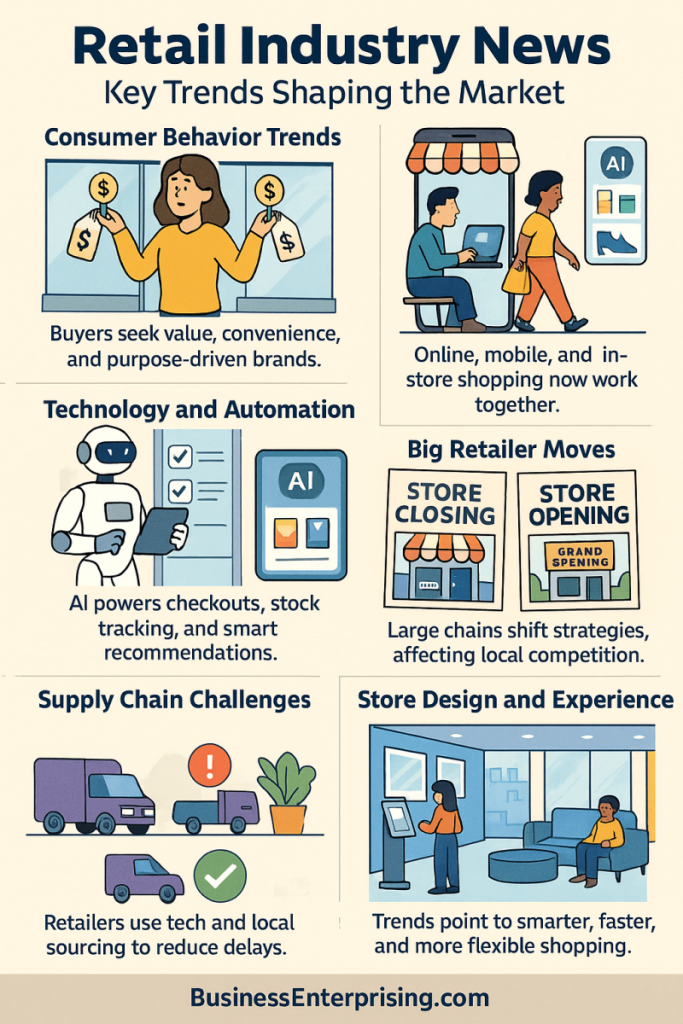
Moreover, trends like mobile shopping, AI tools, and personalized experiences are no longer just options. They have become part of how people shop. Therefore, if you want to stay competitive, your store must reflect what people actually want. You don’t need a massive budget to keep up. Focus on learning from what others are doing and apply what fits your business. Read updates regularly and look for patterns in what’s working across the industry.
Retail moves fast, but you can keep pace with clear goals and steady action. As you follow market news and consumer trends, you’ll find new ways to improve your results. Pay attention to where buyers spend, what they expect, and how stores adapt. These patterns can help guide your next business decision. Keep learning, stay flexible, and always put your customer first.
Consumer Behavior Trends and Shifts
Consumer buying habits continue to shift due to rising prices, faster lifestyles, and changing values. These trends shape how brands connect with customers. Therefore, businesses must watch spending patterns closely to keep up with demand.
Inflation has made shoppers more price-conscious. Many now compare prices before buying or choose store brands to save money. Additionally, people are buying fewer non-essential items and waiting for sales. This behavior forces retailers to rethink their pricing and promotions. However, convenience still drives many choices. Shoppers want fast checkout, simple returns, and flexible delivery. Businesses that make things easier often win customer loyalty. Therefore, streamlining the shopping process is no longer optional.
Sustainability also matters more than before. Many people want to buy from companies that reduce waste or use eco-friendly materials. Younger consumers, in particular, pay attention to how products are made and packaged. Additionally, social values influence purchase decisions in ways that didn’t matter as much a decade ago.
Generational differences shape habits too. While older buyers may prefer stores, younger ones lean toward mobile apps and social media. Therefore, reaching different age groups means using more than one channel. You must meet customers where they are and speak their language. Retail Industry News often reflects these trends. Businesses that adapt quickly stay relevant and profitable. Those that ignore changing behavior risk losing market share. Focus on what your customers need now, not what worked last year. Buying habits change fast. Retailers who listen and adjust can stay ahead.
E-commerce and Omnichannel Developments
Online shopping has changed quickly, and retailers continue to adapt. New tools and buying options are shaping how people shop. Therefore, businesses are investing more in digital convenience to meet growing demand. Mobile apps now play a central role in the shopping experience. Customers browse, pay, and track orders without ever using a desktop. Additionally, many apps offer personalized deals or reminders to restock past purchases. These features help drive repeat business and boost customer loyalty.
BOPIS has also become more common. Customers like the mix of online speed and in-store pickup. They can avoid shipping delays and still get products the same day. Therefore, retailers are expanding this option across more locations and product categories. Moreover, virtual shopping is starting to gain traction. Some stores now use video chats, 3D views, or augmented reality to assist buyers. These features make it easier to explore products remotely. Additionally, they help reduce returns by setting clearer expectations before purchase.
Retail Industry News highlights how these changes shape sales strategies. Businesses that blend online and in-store experiences often perform better. Omnichannel models give customers more flexibility and control. That means more opportunities to drive sales through multiple touchpoints. You should focus on making your digital and physical channels work together. Clients want seamless, fast, and reliable options. If your store doesn’t meet those expectations, someone else will. Stay alert to customer behavior and keep testing what works best. Retail continues to move fast, and so should you.
Retail Technology and Automation Updates
Retailers are using new technology to improve speed, accuracy, and customer experience. These tools also reduce costs and improve decision-making. Therefore, automation is becoming more common across stores and online platforms. AI-powered checkout is one area gaining attention. These systems reduce wait times and help customers complete purchases faster. Additionally, they allow stores to reassign staff to other tasks. This leads to better efficiency and more attention on customer service.
Inventory management tools are also getting smarter. Systems now track product movement in real time and predict restocking needs. Therefore, stores avoid stockouts and overordering. Accurate inventory means fewer lost sales and better profit margins. Moreover, personalized shopping algorithms are changing how people interact with products. These tools suggest items based on past behavior, preferences, and browsing habits. Additionally, they help increase average order value by matching people with what they are most likely to buy.
Retail Industry News often highlights how these tools shape retail decisions. Businesses that use automation can stay ahead of shifting demand. They gain better control over operations and can respond quickly to trends. You should look at how technology fits into your own store strategy. Start small if needed and measure results. Digital tools are no longer optional for growth. They are practical steps that can support your bottom line. Keep testing and refining how you use them. The right setup helps you work smarter, not just faster.
Major Retailer Strategies and Market Moves
Large retailers continue to shift their strategies as they respond to changing demand, costs, and customer habits. These moves affect the entire market. Therefore, small and mid-sized businesses must stay alert to new competition and opportunities.
Some chains are closing underperforming stores while expanding in high-growth areas. Additionally, many are investing in smaller formats that offer faster service and lower overhead. This allows them to serve more local markets without taking on massive space or inventory. However, not all moves involve physical stores. Many large retailers are focusing on e-commerce growth. They continue to improve their websites, apps, and delivery networks. Therefore, smaller competitors must also improve their digital presence to stay competitive. Moreover, price strategies are changing. Some chains are offering more private-label products to keep prices lower. Others are bundling services or offering loyalty perks to increase repeat visits. These tactics affect how shoppers spend and where they choose to buy.
Retail Industry News often covers these shifts closely. The success or failure of large players can signal wider market trends. Therefore, you should monitor how the big names are adjusting their models and offerings. Additionally, their moves create ripple effects. Supplier contracts, marketing campaigns, and staffing models all evolve in response. Stay flexible and ready to adjust if your business feels the impact. Keep your focus on what your customers need, and don’t ignore what large competitors are doing. Their decisions may influence your next steps more than you expect.
Supply Chain Challenges and Solutions
Large retailers continue to shift their strategies as they respond to changing demand, costs, and customer habits. These moves affect the entire market. Therefore, small and mid-sized businesses must stay alert to new competition and opportunities. Some chains are closing underperforming stores while expanding in high-growth areas. Additionally, many are investing in smaller formats that offer faster service and lower overhead. This allows them to serve more local markets without taking on massive space or inventory.
However, not all moves involve physical stores. Many large retailers are focusing on e-commerce growth. They continue to improve their websites, apps, and delivery networks. Therefore, smaller competitors must also improve their digital presence to stay competitive. Moreover, price strategies are changing. Some chains are offering more private-label products to keep prices lower. Others are bundling services or offering loyalty perks to increase repeat visits. These tactics affect how shoppers spend and where they choose to buy.
Retail Industry News often covers these shifts closely. The success or failure of large players can signal wider market trends. Therefore, you should monitor how the big names are adjusting their models and offerings. Additionally, their moves create ripple effects. Supplier contracts, marketing campaigns, and staffing models all evolve in response. Stay flexible and ready to adjust if your business feels the impact. Keep your focus on what your customers need, and don’t ignore what large competitors are doing. Their decisions may influence your next steps more than you expect.
Store Design and Customer Experience Innovations
Retailers are rethinking store layouts to create better shopping experiences and drive more sales. Physical locations still matter, but how they function is changing. Therefore, design now focuses on comfort, flow, and customer behavior. Additionally, many stores are removing clutter and creating open spaces. This makes it easier for people to browse and interact with products. Wider aisles, natural lighting, and relaxed seating areas are becoming more common. These changes encourage people to stay longer and explore more.
Moreover, interactive displays and digital signage are replacing static product shelves. These tools share real-time information and guide shoppers through options. Therefore, customers get a more personalized experience without needing constant staff support. Some stores also use scent, lighting, and music to shape mood and movement. These elements help people feel welcome and increase the chance they’ll buy. Additionally, layout designs now lead visitors toward featured products or high-margin items with purpose.
Retail Industry News often covers how stores test new formats. These changes show how important design is to retail success. Good design supports the brand and makes it easier for people to buy. You should think about how your space affects behavior. If people feel rushed, confused, or overwhelmed, they leave. Small changes in layout, signage, or lighting can make a big difference. Stay open to updates that support the way your customers actually shop. Store design is no longer about looks alone. It’s about function and flow.
Conclusion
Retail continues to shift with every change in demand, technology, or consumer behavior. Staying informed helps you make better business decisions. Therefore, watching trends closely gives you a real advantage in a crowded space. Additionally, your response to these changes matters. If your store adapts faster, you will attract more buyers and build loyalty. From store layout to inventory systems, every detail plays a role in your performance. Keep testing what works best for your customers.
Moreover, digital growth remains strong. Online shopping, mobile tools, and AI-driven features are not optional anymore. They are now basic parts of everyday retail. Therefore, improving your digital channels should stay a top priority for growth.
Retail Industry News reflects what’s happening across all segments. It shows how businesses succeed by adjusting, improving, and staying connected to real customer needs. Additionally, it highlights where gaps still exist, giving you room to stand out. Focus on changes that make shopping easier, faster, and more satisfying. Your customers want value, speed, and a smooth experience. If you provide that, they will come back. Small improvements can lead to big results.
You do not need to change everything at once. Start with what helps most and build from there. Stay clear, stay consistent, and stay responsive. Retail will keep changing, but the core goals remain the same. Listen to your customers, follow what works, and improve wherever you can.



